Program Report on MSDC’s October Presentation by Abigail Nalesnik:
Using Tephra to Unlock the Secrets of Kīlauea Volcano’s Explosive Past
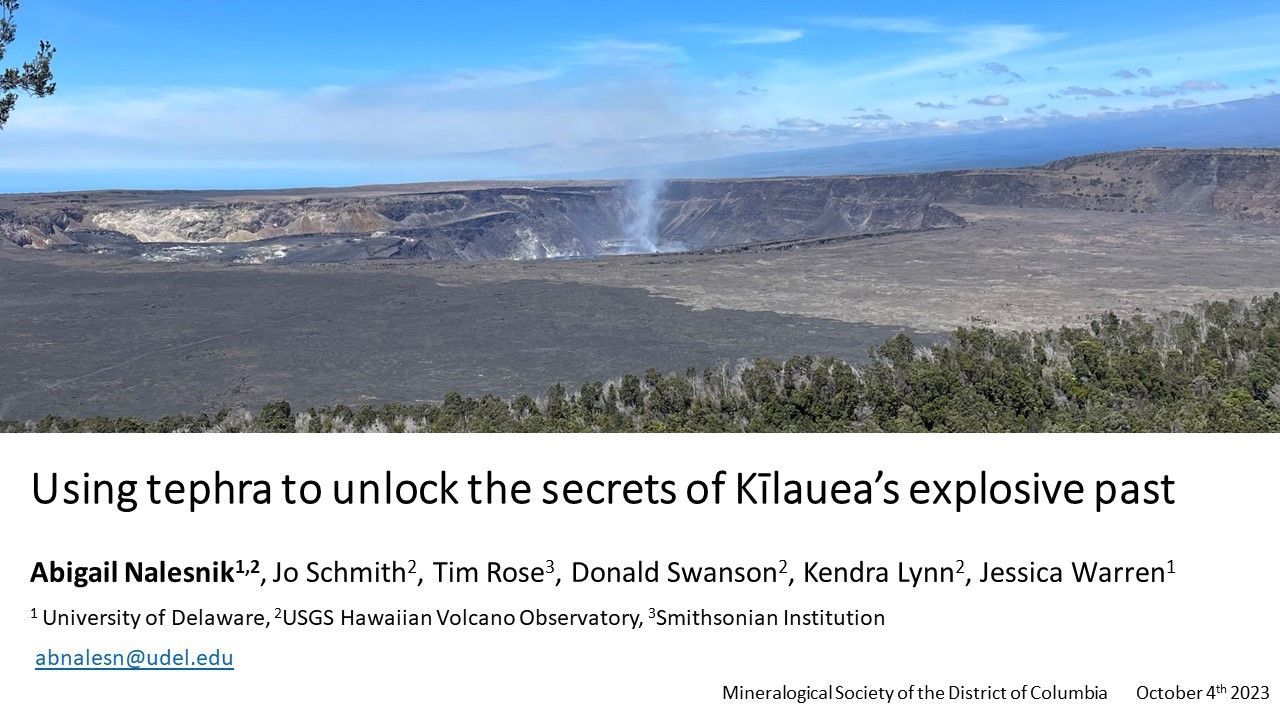
by Andy Thompson, MSDC Secretary
Abigail Nalesnik is a graduate research fellow at the University of Delaware’s Department of Earth Sciences. She first visited Hawai‘i in 2021 to complete preliminary fieldwork with scientists from the U.S. Geological Survey – Hawaiian Volcano Observatory. She has served as a USGS volunteer and is a recipient of an NSF INTERN award that is supporting her current work in Hawaii’i. She is working on her dissertation.
The purpose of this report is to give anyone who missed Abigail’s presentation some of the highlights of her talk. It also opens the door for readers to track current and future research reports by Abby and her colleagues concerning the dynamics and implications of explosive volcanic eruptions.
The Purpose of Abigail’s Research
Abby has been returning to the Kilauea region for the last two years to research its recent, as well as its much earlier volcanic activities, lava flows, and depositions. In recent decades, Kilauea’s volcanic activity has been “effusive,” meaning consisting primarily of lava flows that are more-gentle in nature. But volcanologists know that earlier Kilauea activity, between 400 and 1000 CE, was more explosive in nature, similar to that of Mount St. Helens in the state of Washington.
Abby noted that “too little is known about how those early eruptions happened, their magmatic processes and the physical properties of the tephra itself.” By finding and studying the ancient tephra’s physical properties and the locations where they originally were deposited, she is working to construct a more complete story of those ancient explosive Kilauea eruptions known as the Kulanaokuaiki. These eruptions began as early as 1,600 years ago and continued for about 600 years. Filling in this missing volcanic history will allow scientists “to better understand the shift in these two types of eruptions.”
A Geological Context for the Formation of the Hawaiian Islands
To answer the question “Why Hawaii,” Abby gave her MSDC Zoom audience an overview of how the Hawaiian Islands originated.
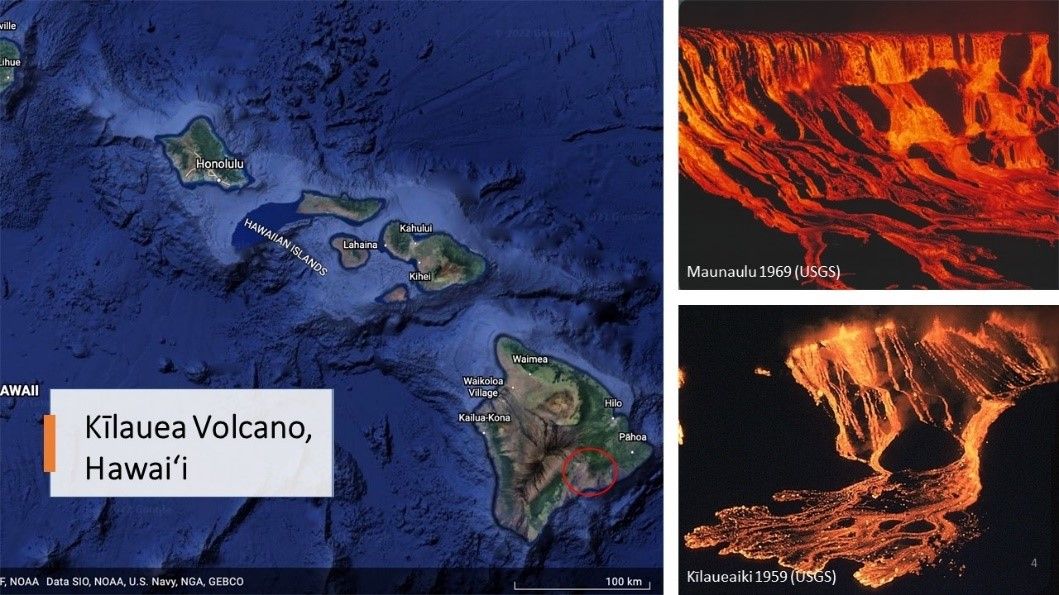
The above images show that the Hawaiian Islands line up and have a northwest orientation as shown in the deep blue image above and to the left. A generally accepted explanation is that as the Pacific tectonic plate moved in a NW direction, a stationary hot spot beneath the Pacific Ocean heated the passing plate, causing volcanic activity which over a long time period sequentially produced each of the islands. The island of Kauai, furthest to the northwest, is the first in the chain and the oldest, with Hawaii (the Big Island) being the last (and youngest), toward the southeast. The Kilauea volcano, the subject of Abby’s presentation, is on the southeast side of the Big Island, in the red-circled area above.
Kilauea is the youngest basaltic shield volcano on the Big Island of Hawaii. It is identified as an effusive volcano, referring to its abundant lava flows. To the right of the above slide are two examples showing the widespread orange-colored lava of the Kilauea Iki eruption of 1959 and the Maunaulu eruption of 1969.
Update on More Recent Kilauea Volcanic Activity
The many slides Abby showed throughout her talk were so vivid her MSDC Zoom audience could practically smell their signature sulfur aroma. Abby explained that, despite the relatively gentle and slow-moving nature of the lava flows, they can be destructive of life and property. The Kilauea 2018 eruption, for example, displayed fountaining and lava flows along several fissures in the lower east rift zone. The flows displaced thousands of residents of the Leilani Estates and resulted in billions of dollars in damage. The drainage of the caldera’s summit down to the level of the rift zone initiated the caldera’s collapse which led to it being as large as it is today.
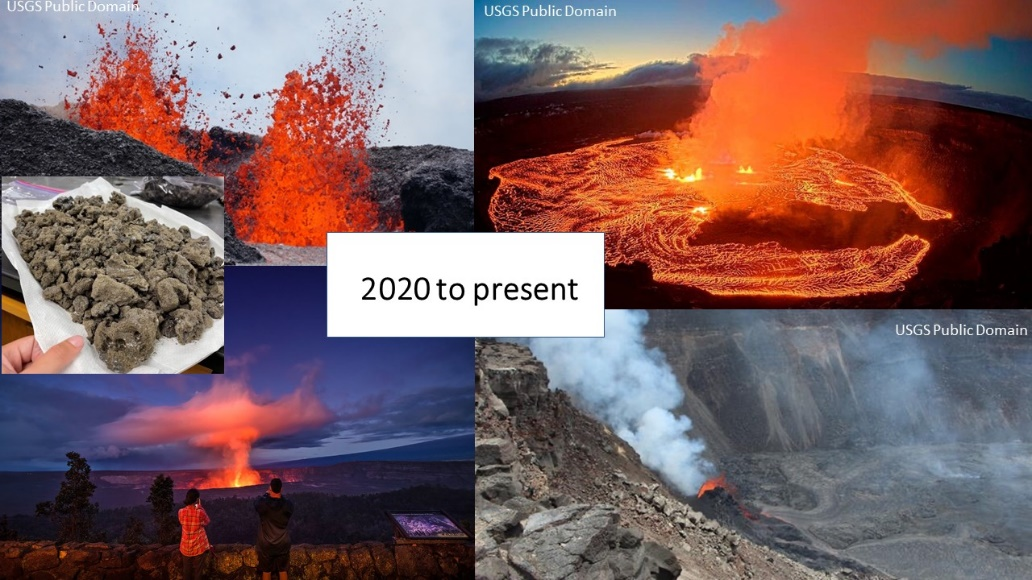
By Christmas of 2020, Kilauea’s water lake was replaced with a lava lake which erupted multiple times with voluminous lava fountains spilling over onto the surrounding areas. Those effusive-style eruptions have become a staple defining recent Hawaiian volcanism and Hawaiian-style eruptions.
These destructive effects underscore the importance of scientific research into not only today’s more gentle effusive eruptions, but also into the magmatic chemistry and dynamics of the earlier, more explosive Kulanaokuaiki eruptions.
Abby emphasized that while these recent effusive lava flows are a staple when defining Hawaiian volcanism and Hawaiian style eruptions, the geologic record shows that Kilauea has not always been a purely effusive volcano. Fortunately, because Kilauea has not been erupting recently, Abby has been able to conduct her research into the deposits of the historically much earlier eruptions as shown below.
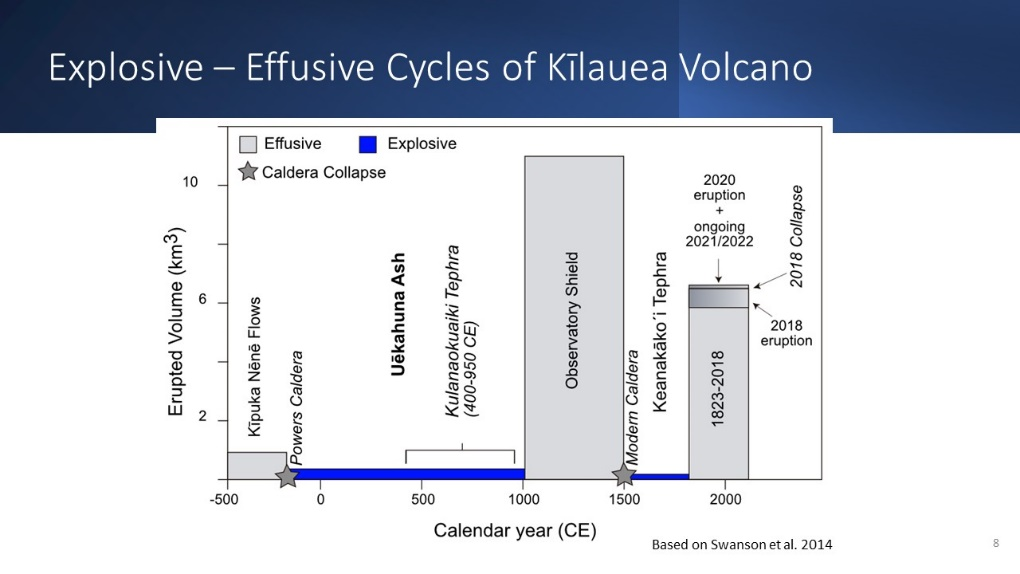
The above chart’s timeline illustrates that for the last 1,000 years, the effusive eruptions (in grey) have prevailed. The explosive eruptions (in blue), between roughly 500 and 1000 CE, are Abby’s research focus. The challenge is to gain insight into what factors might be associated with the shift between the two types of volcanic activity, effusive and explosive. By collecting and analyzing the physical and chemical characteristics of the tephra material ejected from the earlier Kulanaokuaiki volcanic explosions, she hopes to answer this important question.
Vocabulary for Talking about Volcanic Deposits
Abby provided her listeners with the basic vocabulary needed for describing her research subject matter. Along with the basic distinction between gentle “effusive” and “explosive” volcanoes, identifying the material volcanoes ejected is central to Abby’s research.
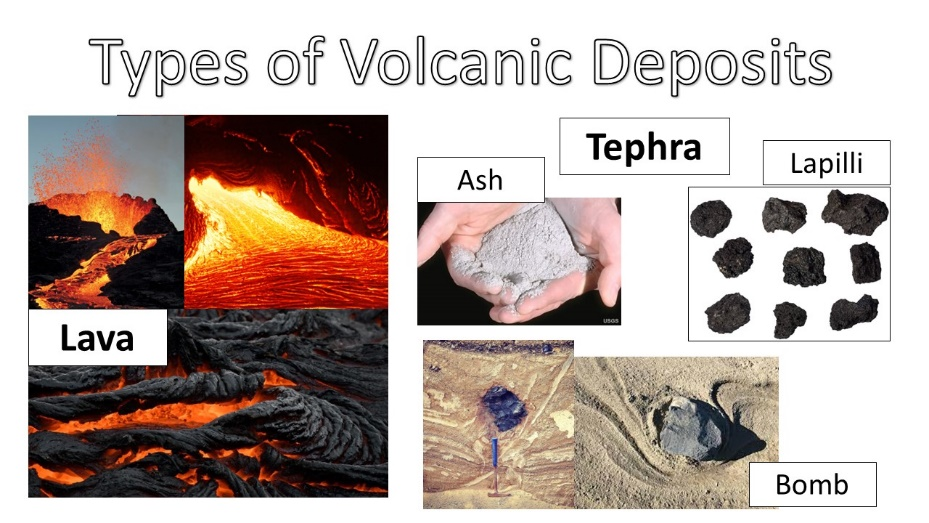
She chose her dig sites based on those documented and published by Tim Rose, Don Swanson, and Dick Fiske between 1992 and 2019 (yellow dots). Abby similarly documented her sites and specified the exact location of each of her tephra samples.
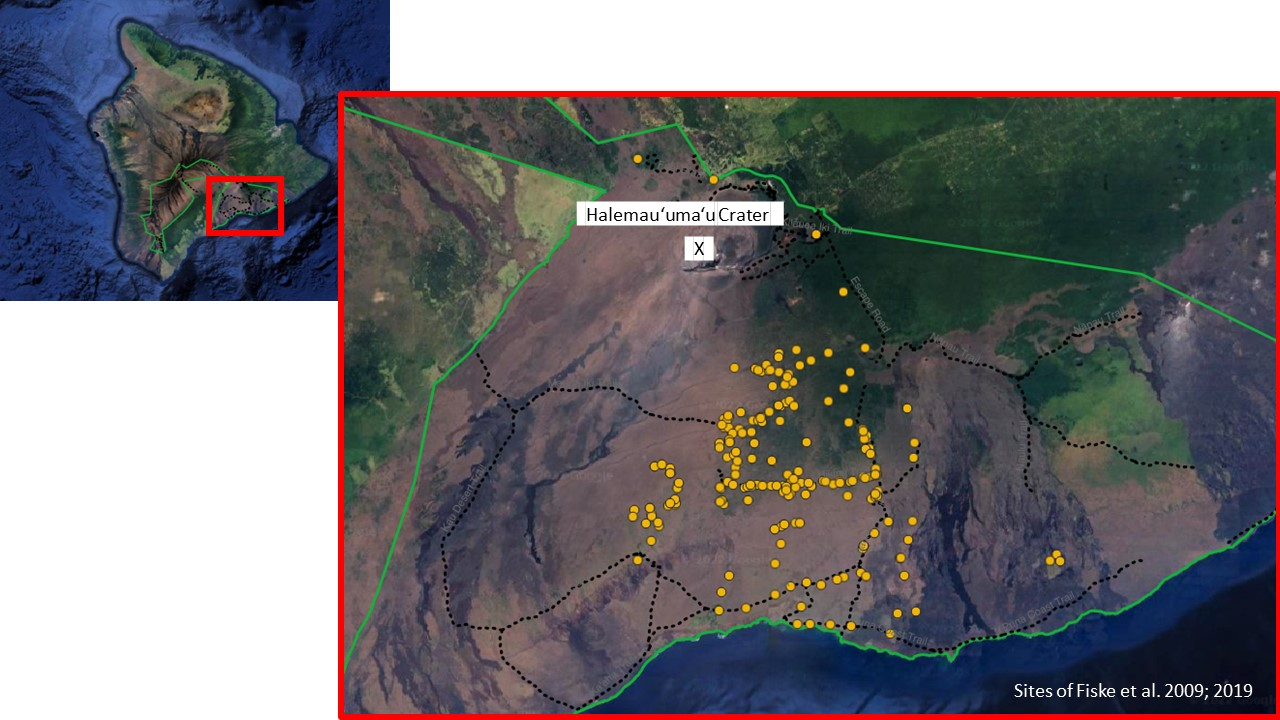
The Kulana tephra on the western and eastern sides of the Kilauea volcano, over the last 1,000 years, was deeply covered by those earlier lava flows. The depositions Abby studied were on the south flank of the Kilauea, deposited there by the trade winds.
As evident in the two images below, when collecting from recent depositions, as shown on the right, she worked closer to the surface. But when collected from the ancient depositions, shown on the left, she had to get below the surface ash and recover tephra samples from deeper below the surface.
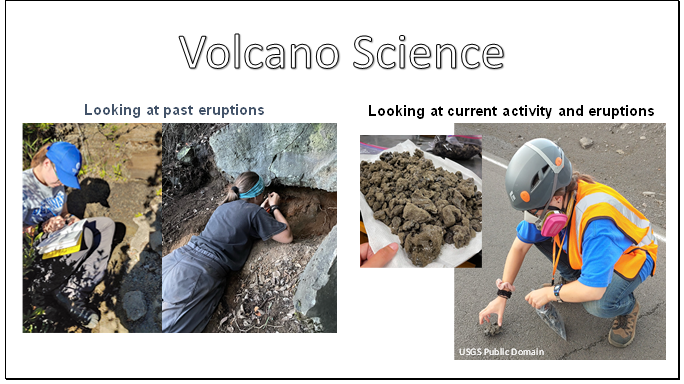
Finding and collecting the tephra was the first step. Abby’s research confirmed earlier work by Richard Fiske, Don Swanson, Tim Rose, and Roz Helz, who found five stratigraphically distinct subunits, Kulana-1 through Kulana-5, which make up the Kulanaokuaiki Tephra. Documenting the locations of the Kulanaokuaiki tephra, their distance from their explosive source, and their location within the five layers was critical. To date, Abby has been to 30 field sites and collected over 250 samples. She takes bulk samples from each of the K-units, as well as sub-samples to investigate the beginning to end of each unit.
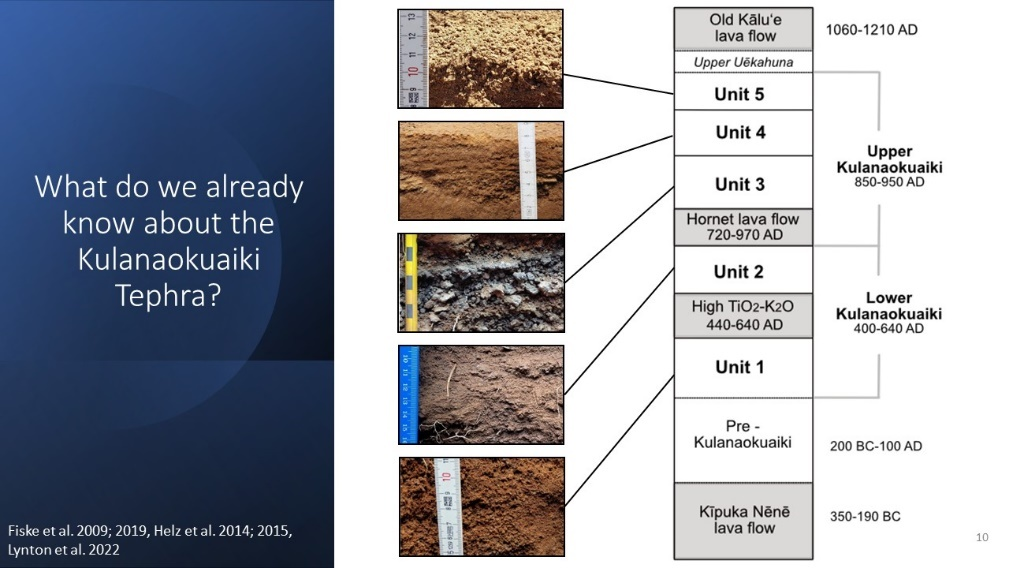
As shown in the stratigraphic column pictured above, she noted there are several interbedded lava flows that are not present at all localities but do help researchers correlate units across the volcano.
The Scientific Methodology Abby Used
Abby explained that once the tephra is ejected, how far its particles travel depends not only on the force of the volcanic explosion but also on the fragments’ shape and mass. When the explosion is large and produces a plume high enough to reach the trade winds, their flight is extensive. The plume that produced some of the Kulanaokuaiki Tephra deposits on the south flank of Kīlauea is estimated to have reached 9–11 miles (14–18 km) high!
She studied the Kulanaokuaiki Tephra deposits to learn more about where the tephra settled, how the eruptions happened and what the physical properties of the tephra itself can share about the magmatic processes. Her focus was those tephra units of primary depositions, meaning those deposits which appear exactly where they originally deposited.
Abby explained the typical sequence of Kulanaokuaiki Tephra from the bottom (the first eruptions) to the top (the last eruptions), as illustrated below.
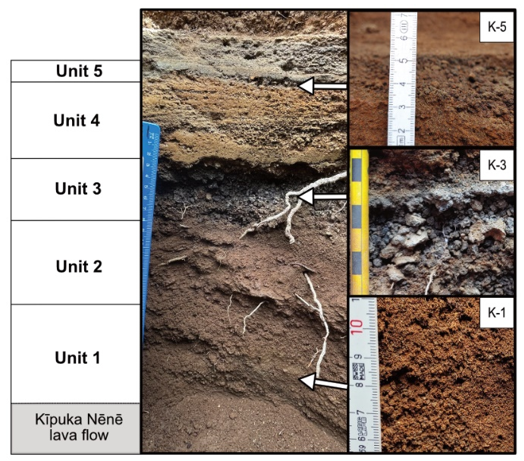
Kulana-1, or K-1, is usually the thickest of the units and is commonly found resting on the Kīpukanēnē lava flow field (350–190 BCE). It is made up of small 0.2–0.4 inch (0.5–1 centimeter) pumice from high lava fountains that lofted this lighter material for several miles.
K-2 is reworked and appears similar to K-1 but is chemically distinct making it useful as a geochemical marker between field sites.
There is a stark color and grain size change in K-3. It’s mostly made up of dark scoria ranging from less than 0.04 inches (1 millimeter) to over 1.2 inches (3 centimeters) in size. Her sub-samples of K-1 and K-3, at several localities, will be useful to explore the properties of each unit from beginning to end.
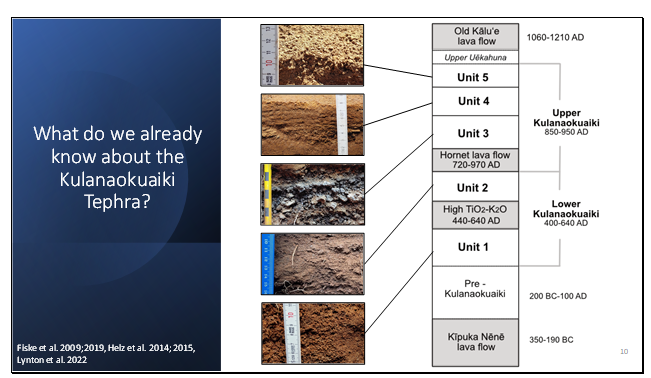
Abby has been building on the earlier research cited above by Richard Fiske, Don Swanson, Tim Rose, Roz Helz, and many others who have investigated Kulana locations, stratigraphic relations, componentry, and chemistry. The consensus is that the Kulanaokuaiki Tephra is defined as five physically distinct units. As illustrated in the strat column above, she noted there are several interbedded lava flows that are not present at all localities but do help researchers correlate units across the volcano.
Abby said she is focusing on the Kulana units 5, 3, and 1 because she found units 2 and 4 to be commonly reworked on the south flank. These three units are the coarsest and thus likely the largest eruptions to have happened during the earlier timeframe. She is particularly interested in the deposition of K-3 scoria with its smaller lithic fragments.
Getting a detailed description of the thickness, grain size, color, sorting and weight of each of her tiny fragments was accomplished by the high-tech instrument for Dynamic Imaging Analysis (DIA) pictured below.
Analysis Using High Tech Instrumentation

The data for all these important variables were obtained by using the below-pictured dynamic imaging analysis (DIA) test in which tiny tephra particles are dropped from a conveyer belt and measured in free fall in front of a very high speed camera. That data even allowed calculation of the speed of the tephra’s ejection from the volcano.
What Abby found was that of the 3 Kulana units, 5, 3 and 1, all had coarse grains. Across all the areas studied, Kulana 3 consistently had the widest range of grain size and was more coarse than what was found in Kulana 5 and 1. And, as expected, the farther she went from the summit area, the less coarse material was found.

As Abby collects more data from the tephra, she will work toward discovering its implications to help the USGS, Hawaiian Volcano Observatory (HVO), government agencies and local communities understand and deal with future eruptions. Her goal is to use the data to think about hazards and perhaps help prepare HVO, government agencies, communities for eruptions like this should they occur today.
Volcanic activity has important consequences for humanity including local and international economies and environments.
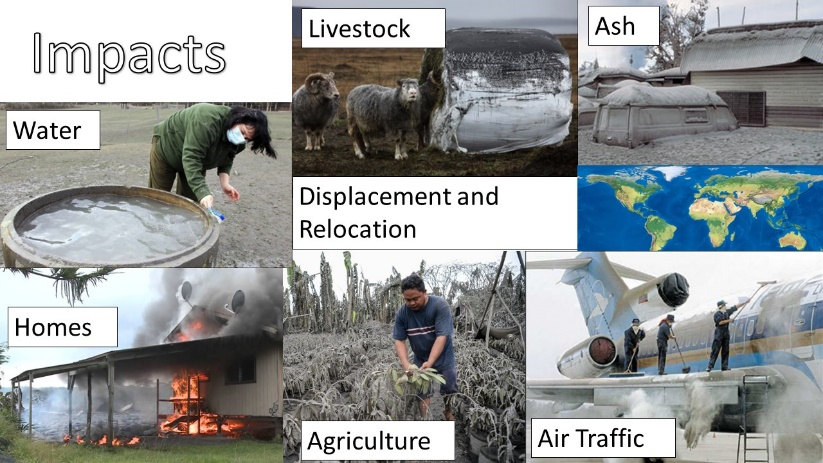
“Understanding how and why these eruptions happen are the scientific questions that are exciting. But I always want to bring it back to how my research will be helpful in the event of an explosive eruption today, where ash might go, its size and how much of it is expected. All this will help communities better prepare.”
Abby summarized her presentation with two simple ideas:
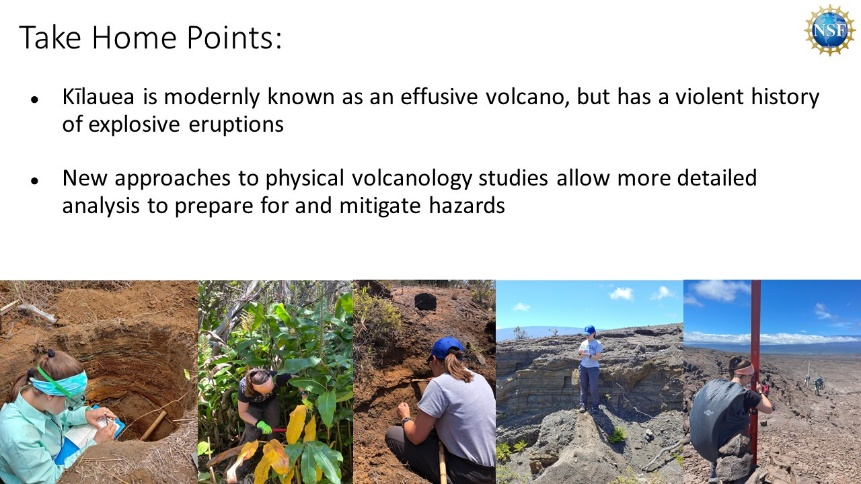
In the follow-up Q & A session, the MSDC Zoom audience then asked Abby questions ranging from:
· a rare Hawaiian plant that is found in only one area,
· variations in the chemical analyses of levels 3, 4 & 5,
· variations in the chemistry associated with grain size, and
· current capabilities in predicting eruptions.
MSDC President Kenny and VP Cindy thanked Abby for sharing such interesting research. The audience expressed their appreciation with effusive and eruptive applause.
MSDC’s Secretary, Andy, gives special thanks to Abby for so very generously sharing her presentation notes and slides, without which the above report would not have been possible.
